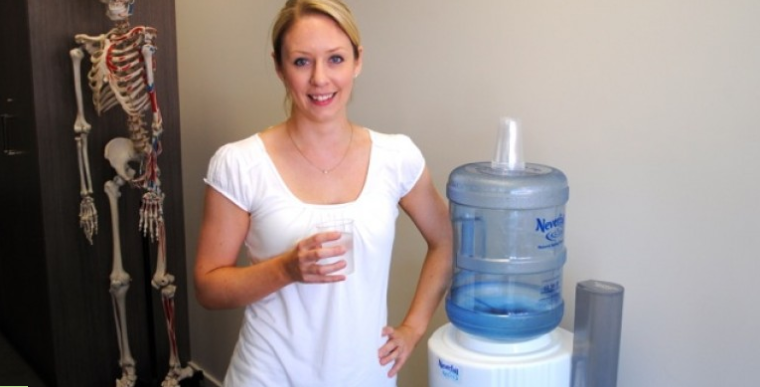
by Dr Eliska Axford | Nov 5, 2017 | Osteopathy Blog
Dr Eliska Axford (Osteopath) is presenting on women’s health, stress and Osteopathy as part of our women’s health and wealth seminars. In her lecture she discusses the physical manifestations of stress within the body and she gets quite technical regarding hormones such as cortisol. We asked Eliska to provide us with some tips to help reduce stress within the body.
Eliska’s 5 tips to reduce stress in your body:
1. Relaxing: When you’re driving, and you stop at a set of lights, drop your elbows and relax your shoulders.
2. Time-Out: Take breaks from your workstation regularly, I suggest every 30-45 minutes to reduce the chance of falling back into “slouchy spine”. Take a walk to the water fountain, around the office or to the bathroom to get your blood pumping again.
3. Breathing: Take 3 deep belly breaths, counting to 5 on the way in and 5 on the way out.
(See below for a description of a belly breath and why it may help reduce your stress)
4. Replenishing: ensure you drink 2L of water per day – but don’t fill up a big drink bottle, you’ll tend to drink more if you have a small 200ml cup on your desk and try to drink one glass every hour, it only takes a few gulps.
5. Stretching: particularly for those areas of the body that are compressed or under tension, two of my favourite ones are a lateral neck stretch and a pec stretch, both of which I find people benefit from doing intermittently throughout the day especially if they are using computers, electronic tablets or phones a lot.
Stretch 1. Lateral Neck Stretch:

This is a general neck stretch that is often suitable when you’ve been at the desk on the computer.
Aim: It targets the scalene and your upper trapezius muscles where many people experience tension.
Caution: If you have a specific injury you should consult your Osteopath before attempting any stretches or exercises.
Method:
Step 1 – Gently sitting on your hand, keeping your shoulders down and level.
Step 2 – Laterally bend your head to the right.
Step 3 – Take the left side of your head in your right hand. Gently draw your head and neck to the right. Hold 20-30 seconds and gently return to the centre. Repeat for other side.
Stretch 2 – Chest Stretch.
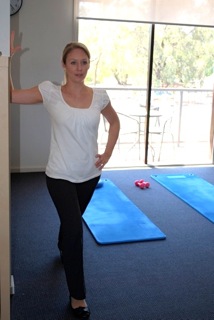
This is a general chest stretch that will stretch the pectoral muscles and aims to encourage an upright posture (helps to avoid the slouchy posture). If you are a regular mouse user, you may choose to spend a little more time doing this stretch on the side you use your mouse on.
Caution: If you have a history of shoulder dislocation or instability this may not be suitable for you, please consult your Osteopath for clarification.
Method:
Step 1 – Standing near the edge of a wall or in a door way bend your elbow to 90 degrees and place your palm and forearm against the edge of the wall as in the picture above.
Step 2 – Place the same leg forward as the arm you are stretching. Gently moving forward you should start to feel a stretch in the chest area.
Note:
– If you experience any pain in the shoulder joint with this stretch, stop immediately and consult your Osteopath.
– Lightly contracting your abdomen can reduce the torsional or rotational forces into you mid and lower back.
Belly Breathing:
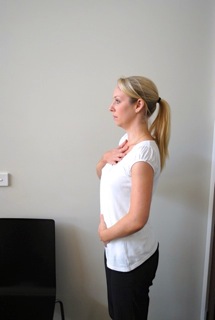
To perform a belly breath you may find it beneficial to place one hand on your chest and one hand on your belly.
Using the hand on the chest area you can monitor and try not to move the chest whilst performing these breaths.
The idea with a belly breathing is to use your diaphragm muscle under your rib cage and to avoid using the scalene muscles in your neck. The scalene muscles are often over worked and can contribute to neck tension.
At times of emotional stress and meeting deadlines we often find ourselves at a desk performing any number of tasks. When you are seated at a desk especially after a big meal or when you are pregnant your diaphragm may be compressed and thus you often revert to using those scalene muscles in the neck again to assist with respiration. Just performing this simple task can often see people experience a reduction in neck tension and thus they will often cope better with a whole range of stress issues.
If you have any further questions regarding Eliska’s tips to reduce stress or feel you may benefit a consultation with Eliska please don’t hesitate to contact our receptionist to arrange an appointment. Ph. (03) 9431 5773 or info@gatewayosteo.com.au
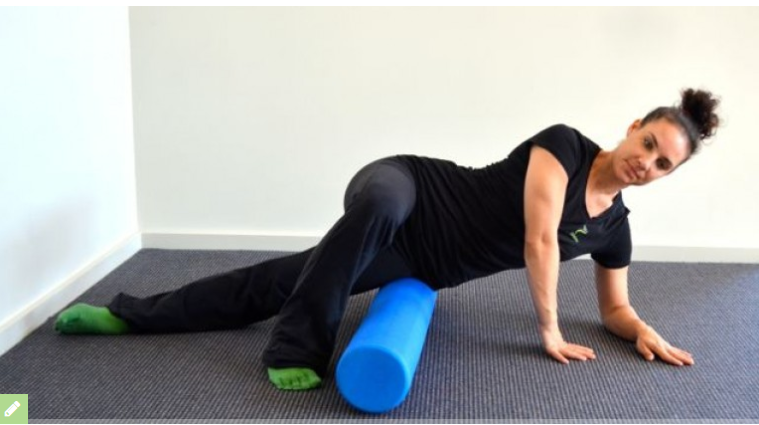
by Dr Stuart Robbins | Nov 5, 2017 | Pilates Blog
This article is not going to cover if you should or shouldn’t be using a foam roller to release your ITB as this is a clinical decision that should be made by your Osteopath or other practitioner based on your presentation and a range of factors.
This article is designed as a reminder to aid patients whom have been prescribed this exercise as part of their management plan.
* Cautionary note: When using a foam roller to release your ITB in this manner it can put stresses through the lower torso, specifically the low back and if you have a weakness or an existing injury in this region this may not be suitable for you. To assist with this it can be beneficial to maintain a mild contraction through the lower abdomen to assist in protecting your back.
- Lay on your side with the roller placed on the under side of your thigh positioned somewhat perpendicular to your body.
- Using the elbow and forearm of the arm closest to the ground to support your upper body and the outside part of the leg closest to the ground to support your lower body.
- Trying to keep your body as neutral as possible – that is in a straight line.
- Use your limbs closest to the ceiling to moderate the pressure with which the roller pushes into your thigh.
- The “rolling” component of this activity refers more to gaining position than actually rolling. From our experience you get the best release in the tissues by pausing at tender points and allowing the tissue to soften rather than rolling over it repetitively.
- You may need to pause on a tender spot and wait for the tissue in your thigh to release. This can take longer than a minute sometimes.
- When performing this exercise it is common to experience a level of discomfort however overt pain should always be avoided.
- Be careful not to over do it, pushing harder can lead to extreme discomfort, therefore leading to increased tension and the whole process becoming counter productive.
- Perform this exercise for the frequency and duration as advised by your Osteopath or Pilates Instructor.
Authors thoughts on using foam rollers in general and for ITB release.
We use foam rollers and other devices for self massage (self myofascial release). By applying pressure to tender areas of your body you can achieve decreased tissue tension. This enables muscles to return to their normal length and function. By using a process of self massage your muscles will be healthier, more elastic and ready to perform.
As a practitioner the idealist in me thinks that if a patient is performing a well balanced exercise program, then they may not actually need to use a roller at all. This said, most of us (myself included) are often squeezing some type of exercise into an already busy lifestyle. I feel the foam roller is a great tool to assist people in performing some self body maintenance exercises. The popularity of foam rollers is a result of their effectiveness to help so many people both resolve pain and keep doing the types of exercise they enjoy.
Why do many of us need to release our ITB’s in the first place?
Foam rolling for your tight Iliotibial Bands (ITB’s) may provide somewhat symptomatic relief for a number of conditions. Clinically I often see one iliotibial band much tighter than the other, and this is commonly accompanied by a muscular imbalance in the glutes, quadriceps, or even chronic ankle instability. Furthermore, using a roller should be accompanied by joint assessment and treatment including soft tissue therapy, joint manipulation and possibly some corrective exercises.
Tight ITB’s may also be a reflection of poor technique in a regularly performed exercise for example a squat or a lunge, or simply overtraining and not programming adequate rest periods.
Whilst tightness in this region seems to be something I see in people from all walks of life it definitely is something that I see a lot of in the very active, aspiring athletes and professional athletes. I don’t necessarily believe these people have any worse biomechanical faults compared with asymptomatic people more so that they push themselves to a level where their biomechanical faults and muscular imbalances are more overt.
Written by Dr Stuart Robbins (Osteopath)
* Foam Rollers are available at our clinic ask at reception.
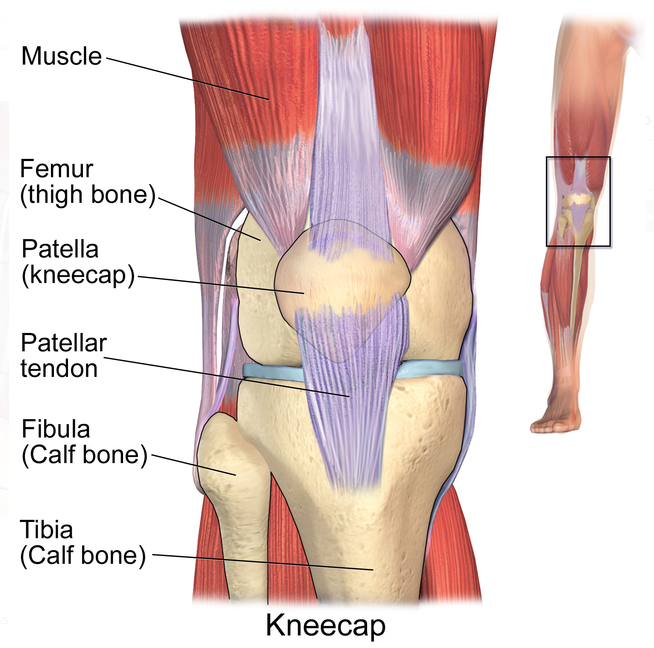
by Dr Jessica Bowman | Nov 5, 2017 | Excercise Library
Patellofemoral Pain Syndrome
Author: Dr Jessica Bowman (Osteopath)
We asked Dr Jessica Bowman if she could tell us a little about a common knee complaint, here’s what she had to say.
What is patellofemoral pain syndrome?
Patellofemoral pain syndrome is one of the most common causes of pain behind or around the kneecap. It is usually the result of abnormal tracking of the kneecap through the femoral groove as the knee flexes and extends, making it rub against the femur. This can cause joint irritation and, eventually, degeneration of the underside of the patella.
What causes it?
A number of factors can cause aberrant tracking of the patella. Usually, there exists a tightness of the Vastus Lateralis, which pulls your patella outwards, in combination with a weakness of the hip stabilisers and the Vastus Medialis, which usually pulls your patella up and inwards. This results in the kneecap being pulled to the outside of the knee.
Common reasons for a weak Vastus Medialis include overuse, injury, or disuse.
What are the symptoms?
People with patellofemoral pain syndrome tend to experience pain around or behind the kneecap. This is especially apparent with activities requiring the extremes of knee flexion, such as kneeling, squatting, running, or ascending/descending stairs.
What can my osteopath do to help?
The aims of treatment for patellofemoral pain syndrome treatment are to ease pain and inflammation, maximise circulation for fast healing time, and to correct the causative underlying strain. With these in mind, your osteopath will:
- Restore biomechanical balance to the lower extremity, pelvis and lumbar spine.
- Tape the knee to support patellofemoral realignment.
- Diagnose any weak musculature present and prescribe a range of stretching and strengthening exercises to be performed by the patient at home.
- Provide advice on appropriate pain management, such as the use of a simple pain killer and avoidance of exacerbating activity.
From my experience approximately 90% of patients with patellafemoral pain will be pain-free within 6 weeks of beginning treatment.
What kind of self-management strengthening and stretching exercises can I expect?
Your osteopath will tailor a stretching and strengthening program to your individual needs, however some frequently prescribed exercises include:
1. Foam roller knee extension: 3x sets of 15 repetitions each side
- Sit on the floor with your back supported against a wall.
- Place a foam roller (or rolled up towel) underneath the lower thigh/knee.
- Turn the toe out approx. 30⁰.
- Squeeze the front of the thigh- focussing on the VMO- to lift the heel off the floor and push the back of the knee into the towel.
- Return to the start position and repeat.
- Repeat on opposite side.
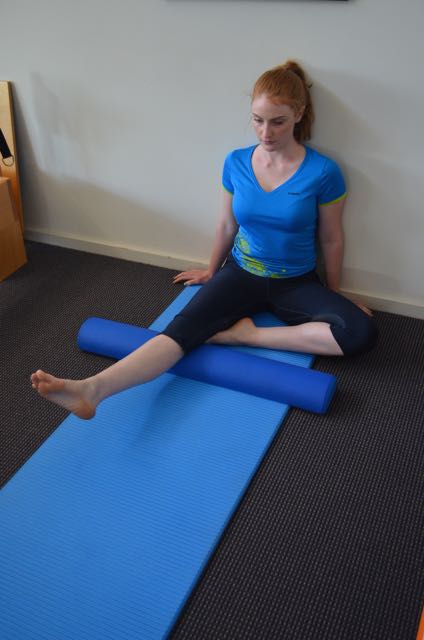

2. Swiss Ball Squeeze: 3x sets of 15 repetitions each side
- Position feet shoulder width apart, with the swiss ball behind one knee such that it creates a slight bend in it.
- Contract your Transversus Abdominus (suck belly button in towards spine) and stand tall.
- Gently extend the knee into the ball, focussing on squeezing the VMO.
- Return to the start position and repeat.
- Repeat on opposite side.
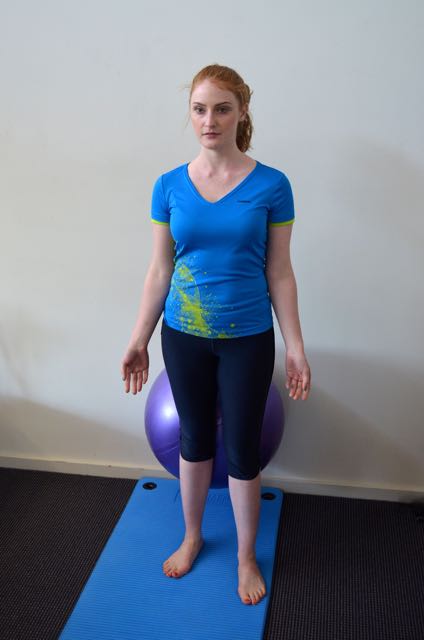
3. Toe- out lunge: 3x sets of 12 repetitions each side
- Position one foot at a comfortable distance in front of the other. Each foot should be in front of the corresponding hip.
- Turn the toes of the front foot 10⁰ away from the midline of the body.
- Contract your Transversus Abdominus (suck belly button in towards spine) and stand tall.
- Maintaining approx. 80% of the weight on the front foot, bend the front hip and knee into a lunge. Hold on to something for support if required.
- Return to the start position and repeat.
- Repeat on opposite side.


4. Clams: 3x sets of 20 repetitions each side
- Lie on your side and bend your knees in front of you so that your thighs are perpendicular to your hips and shoulders, which should be in a straight line.
- Rest your head on your bottom arm. Place your top arm on the floor in front of your chest for stability.
- Raise the top knee towards the ceiling, allowing your hip to rotate in its socket. Keep the heels together, and only open the knees as far as you can go without allowing the pelvis to tilt forward or backward.
- Slowly and with control, bring your knee back to the start position and repeat.


5. Theraband Squat: 3x sets of 12 repetitions
- Step through the theraband loop and wrap it around or just above the knees.
- Contract your Transversus Abdominus (suck belly button in towards spine) and stand tall.
- Simultaneously bend at the hips and knees- being careful not to slump through the thoracic spine- and squat as if sitting into a chair. The head should remain facing straight forward, and the knees should track over, but no further than, the toes.
- The movement should end as the angle at the knee reaches 90⁰. Rise and repeat.
- Stand with the feet shoulder width apart, such that all slack is taken out of the band.
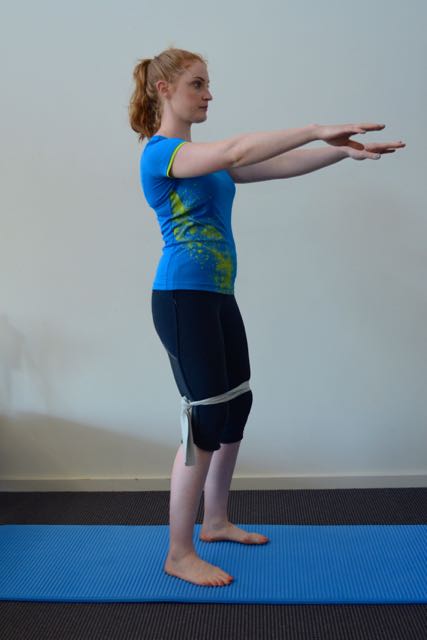

6. Hamstring Stretch: Hold 30secs-1min each side
- Standing up, place one heel on a raised surface with the knee slightly bent.
- Contract your Transversus Abdominus (suck belly button in towards spine) and stand tall.
- Lean forward from the hips- without slumping forward through the thoracic spine- until a slight stretch is felt in the middle of the hamstring muscle belly (if you feel it behind the knee, you’ve bent too far forward).
- Accentuate the stretch by gently straightening the knee.
- Rise and repeat on the opposite side.


** Please note whilst this article includes some general information, patellofemoral pain can be quite complex. A thorough diagnosis is always necessary before determining the exercises that are the best course of action. If you have knee pain and are seeking information, the best thing to do is book with one of our Osteopaths for a more tailored treatment and exercise regime.




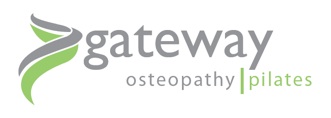














Recent Comments